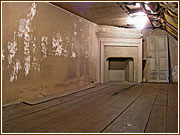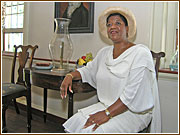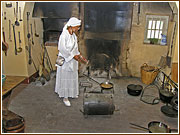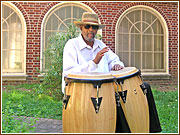IN MEMORY OF POMONA HALL'S SLAVES
Camden Group Performs Ritual 'Purification'

By Hoag Levins ...| ...August 1, 2005

CAMDEN, N.J. -- In a historic ceremony that sought catharsis for the souls of the living as well as the spirits of the long dead, eight African-Americans on July 23 conducted a ritual purification of the Pomona Hall spaces where their ancestors once worked as slaves.

|
| Photo: Hoag Levins |
The eight people who took part in the slavery purification rite were (top row, left - right) Sandra Turner-Barnes, Hettie Smith-Victory, Beverly Collins-Roberts, Betty Leacraft and Saran Bademosi; and (bottom, left-right) Ed Stokes, Gerald Roberts and Horace Broughton who are holding traditional music instruments called vaccines. Click for larger view.
|
Now a facility maintained by the Camden County Historical Society, Pomona Hall was formerly the home of various members of the Cooper family that founded what is now the City of Camden. Initially erected in 1726 by the white colonists, Pomona Hall was expanded into its final form in 1788 as the grand mansion of Marmaduke Cooper, one of the region's wealthiest businessmen.
Slave names
Research by the Historical Society begun in 2002 has documented the names of 14 of the African-American slaves owned by Mr. Cooper, whose 400-acre property across much of what is now Parkside included fruit orchards, field crops and livestock operations.
Organized by Camden photographer and cultural arts advocate Beverly Collins-Roberts, the purification rite kicked off a three-month "Still Standing" commemoration of local African-American history that runs from August through October in various venues around the city. Ms. Collins-Roberts has been researching the history of 18th-century slavery in Camden for three years.
She first became involved with the Historical Society in 2002 when she was one of a dozen local artists whose work was featured in the Society's African-American Experience art show. At that time, she learned about the Society's recent discovery of slave records from the now-deceased former executive director, Judith Snyder.
"Judy is the person who really got me going in all this," said Ms. Collins-Roberts,

|
Camden photographer Beverly Collins-Roberts organized the Pomona Hall purification as part of her larger "Still Standing" African-American history and arts project.

| "I cried when she passed last year because she and I became such good friends."
Photography project
The photographer, whose great-great grandfather was Philadelphia abolitionist and Underground Railroad activist William Still, was initially shocked to learn that slaves had once worked Camden plantations. But as an artist, she was also electrified at the prospect of wandering at will with her cameras through the spaces of a 300-year-old structure where generations of those 18th-century African-Americans had been born and died, worked and slept, laughed and cried. She was given free access to roam Pomona Hall over the next year and from the earliest days of the project, she spoke about the strange and powerful emotions she felt every time she climbed a creaking narrow staircase into the third floor attic area.
In February 2003, a 24-year retrospective of Ms. Collins-Roberts' photography -- including a collection of her new Pomona Hall images -- went on display in the Society's newly refurbished Boyer auditorium gallery.
Since that time, Ms. Collins-Roberts, who is the mother of four, has been researching and organizing the "Still Standing" program highlighting the history of slavery, the Underground Railroad and other aspects of African-American life in Camden. That series of public programs, which runs from August to October, includes events at different venues around the city, including the Historical Society.
Historical reality
She said the Pomona Hall purification ceremony was designed to honor the 14 individual Cooper plantation slaves whose names are known and publicly acknowledge the larger historical reality that slavery was an integral part of 18th-century life here.
"When you say 'slavery,'" she pointed out, "most people -- black and white -- don't think about northern states at all, let alone southern New Jersey where they

|
| Photo: Hoag Levins |
The section of Pomona Hall's large attic where the purification ceremony took place. Click for larger view.
| live. And when I first started this project, some of my own people kept saying to me, 'Nobody really wants to know about this. Slavery is too painful.'"
"But as I kept coming back with more information, the same people started to get more interested and ask questions. Fact is, even though it's painful, African-Americans are hungry for more history about ourselves -- and we deserve to know everything there is to know," she said.
Uncomfortable subject
"At the same time, I DO understand that the subject of local slavery is uncomfortable for many people -- but what we're doing is not a negative thing; we're celebrating our own history, not pointing fingers. I feel this is part of a healing process that is still going on centuries after African-American slaves were first auctioned off at Cooper's Ferry on the Camden waterfront."
Motioning toward Pomona Hall's master staircase just before the purification began, she noted, "Many people believe that the spirits of individuals can linger on in places where they have suffered traumatic experiences. It's like the spirits seem to be unable to leave, or maybe they can't go because they know that something that needs to be done isn't done yet."
"I feel that this is what is happening here this morning," she said. "It's almost like the spirits of our ancestors were still here because they couldn't leave until those who came after them finally learned about their existence. And we are now closing that circle. We're telling our ancestors' spirits that they can finally move on to find their own peace; that we know who they were, we appreciate what they endured, and we'll never let the facts of their lives be hushed up again."

|
| Photo: Hoag Levins |
Sandra Turner-Barnes, Director of Development & External Affairs at Camden's
Walt Whitman Arts Center sits in Pomona Hall's dining room as she waited for the ceremony to begin. Click for larger view.
|
Dressed in white
Ms. Collins-Roberts, who was covered head-to-toe in white, was then joined by four other similarly dressed women. One of them was Sandra Turner-Barnes, director of development and external affairs at the Walt Whitman Arts Center in Camden. Ms. Turner-Barnes is a descendent of Joshua Sadler, who escaped from slavery on the southern shore of Maryland in 1820 and took refuge in an area that is now Cherry Hill. He later helped establish a small community of former slaves called Sadlertown in what is now Haddon Township.
"I've always known who my ancestors were and found a sense of peace and completion in that," said Mrs. Turner-Barnes. "I'm here today to help pay tribute to other ancestors that none of us knew about until recently. It's very exciting to be connecting the dots of history like this so that the truth becomes part of what we all know about ourselves and the place where we live."
Symbolic cleansing
Then, as somber and dignified as a church service, the purification ceremony began with a symbolic cleansing of the mansion's main rooms conducted by Betty Leacraft, a Philadelphia fiber artist and teacher.
Regally dressed in flowing robes and a head wrap, she carried burning sticks of sandalwood incense in one hand and a tightly-bound clump of smoldering sage in the other as she walked the perimeter of the rooms. Stepping down into the open-hearth kitchen, she walked the room, hesitated for a moment, and then walked the room again, as if it needed extra cleaning.
"Some things don't have a real definite explanation," she said. "When I walked in

|
| Photo: Hoag Levins |
Betty Leacraft was particularly touched by the open-hearth kitchen as she moved through each of the building's spaces to perform a symbolic cleansing rite. Click for larger view.
| here and saw the hearth and the heavy iron pots and all the iron implements, I just felt something that made me want to walk around the room twice. Back then, just like now, the kitchen living space would have been the heartbeat of the house and I know this would have been the domain where slaves spent a lot of time."
As Ms. Leacraft finished, she joined the other four women who proceeded up the three flights of stairs connecting the main part of the mansion with its attic areas.
Traditional instruments
Marching behind them and playing the Didgeridoo-like bamboo instruments called vaccines (pronounced va-scenes), were three members of the local Black Beans traditional musical group.
In the attic, the assembled group called out the name of each slave, ringing a bell and leaving a moment of silence each time. Water was poured on the floor as a ceremonial libation, an act that was a normal part of a ritual African offering to the gods.
A poem entitled "Sweet Land of Liberty" by Ms. Turner-Barnes was read aloud and the three vaccines filled the angle-roofed attic space with a sad and plaintive sound that evoked scenes of the Middle Passage for some.
After a round of remarks, the musicians played their way back down to the first floor as the five women gathered privately in second floor room to gather their thoughts.
Pain and jubilation
"I can't put into words what I am really feeling at this moment," said Ms. Collins-Roberts, who sat down in a rocking chair and reached out to instinctively take the hands of the other women gathered around her so that they were all

|
| Photo: Hoag Levins |
Playing drums in the courtyard of Pomona Hall during the event was Lenny Fooks of the Black Beans traditional music group. Click for larger view.
| connected. "I've been working on this for three years and it's now happening. I feel a sense of relief and a sense of pain mixed with such jubilation," she said. But then she stopped abruptly to attend to the tears filling her eyes.
Downstairs, as the sound of African drums played outside the open-hearth kitchen window, Historical Society president Richard Pillatt called it "a very moving and emotional day."
"This event underscores how history is a living thing that continues to grow and enrich and engage us all," he said. "It has given us even more reason to continue the work of preserving this house whose very walls bear witness to the daily life and times of the slave-owning farm culture from which the city and county of Camden grew."
~ ~ ~
| 


